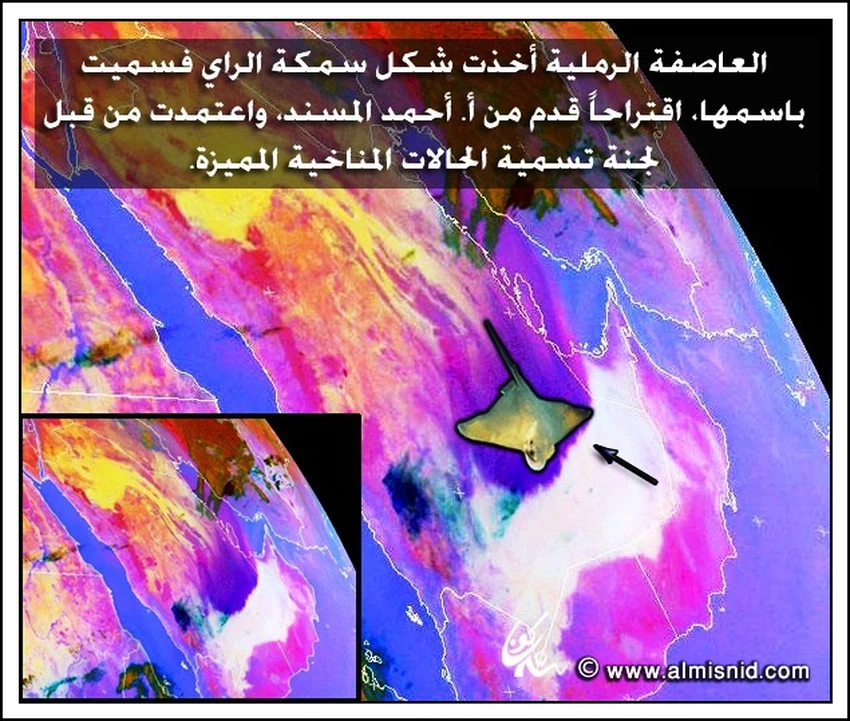Saudi Arabia - video | Statistically speaking, the strongest sandstorms that hit the Kingdom were not in the fall
Weather of Arabia - Although we have astronomically entered the autumn season, near the beginning of the season and the high chances of weather fluctuations in the Kingdom of Saudi Arabia, autumn is considered the season with the least sand storm formation statistically, and going back to the history of the sand storms that recently affected the Kingdom, it turns out that they were concentrated between the months of March and April, and in our next report we review together the 4 most prominent sand storms that affected Saudi Arabia during the past 20 years:
I left in March and April
The 4 strongest sand storms that affected Saudi Arabia did not occur in the fall
Sandstorm orbit
It is the last of the strong sand storms that affected Saudi Arabia. Its impact occurred during the period from March 17 to 20, 2017, and the storm Madar had begun to form north of the Libyan lands, moving quickly towards the Egyptian lands, then the Levant, the Kingdom of Saudi Arabia, and the Arab Gulf states.
The storm was formed as a result of the formation of a deep air depression north of Libyan territory, which caused sand storms to form and move towards Egypt, causing a complete cessation of maritime traffic in Egypt and Libya. Then it moved towards the Levant and Saudi Arabia, and caused air traffic to be obstructed due to the lack of horizontal visibility, which reached up to Zero in some areas and turned the day into complete darkness.
A majestic clip of the #Madar_storm entering Buraidah in central #Saudi Arabia and how the day turned into complete darkness in seconds #Arab_Weather #Saudi_Weather #Weather pic.twitter.com/54xgtdFxnQ
- Arabia Weather - Saudi Arabia (@ArabiaWeatherSA) March 19, 2017
Dark storm
On April 1-2, 2015, large areas of the Arabian Peninsula and Saudi Arabia were affected by a strong sandstorm, which was called a dark storm. The name was given in reference to the darkness that dominated large areas of Saudi Arabia at the moment of the storm’s entry, as it caused the complete disappearance of the sun’s disk and the day turned into night in many cases. From regions, including the capital, Riyadh.
The dark storm also affected Qatar, Bahrain, and the Emirates, then Oman and Yemen. It can be classified as among the most severe sand storms that have affected the region throughout modern history, as the area of the areas affected by the storm exceeded one and a half million square kilometers.
One of the most distinctive features of this sandstorm is the complete lack of horizontal visibility in Riyadh, Dammam, Rafha, Manama, and Doha. Horizontal visibility in these countries reached zero, while horizontal visibility decreased sharply in Dubai and Abu Dhabi to less than 200 metres. The speed of wind gusts during the impact of the sandstorm reached 105 km/h in Rafha, northern Saudi Arabia. This led to massive dust formation.
Ghost Storm
It is a massive, dense sandstorm that affected the Levant and Iraq, then the Gulf states in general, in mid-March 2012.
At that time, several regions in the Arab Gulf states and Iraq lived under the weight of a series of dust storms that spread from Iraq towards several regions in the Kingdom of Saudi Arabia. It covered Al-Ahsa, Riyadh, Jeddah, and many eastern and central Saudi regions.
The storm had arrived in Khafji, coming from Iraq, and it was severe, limiting horizontal visibility to zero percent, with a total area estimated at 3,900 square kilometers, and the length of the main dust mass was 1,100 km and its width was 500 km. The storm struck the eastern regions, the Gulf states (Kuwait, Qatar, Bahrain, and the Emirates) and the central region. From Hail in the north to Wadi Al-Dawasir, then the south, and then it reached Yemen, returning with southwesterly winds, sweeping the west, the Red Sea, and the coasts of Egypt and Sinai.
Storm ray
The storm began on Friday, March 25, 2011 AD, and formed close to eastern Rafha and southern Iraq, and began to creep to the south and expand. It struck parts of the Central District and the entire eastern region, in addition to Kuwait, Bahrain, and Qatar, then the Empty Quarter and southwestern Saudi Arabia, until it reached the Gulf of Aden. The storm continued in the atmosphere of Saudi Arabia, active and intense, for three days, while the plankton continued longer than that. It is noteworthy that this dust storm has become international; It affected 12 countries (the Cooperation Council, Iraq, Iran, Yemen, Djibouti, Somalia and Pakistan), and five sea bodies (the Arabian Gulf, the Red Sea, the Gulf of Aden, the Sea of Oman and the Arabian Sea), and even deepened into the Arabian Sea south for about 1,400 km. What makes it a historic and distinctive dust storm.
The ray storm was characterized by its speed (about 50 km per hour), its frightening intensity, its long stay in the region’s atmosphere, its curved (clockwise) and long geographical path, its bounce back to the north after colliding with the Asir Mountains through the southern winds, and its arrival again, bouncing back to its origin after four days. days of its formation, and part of it went deep into the Arabian Sea for more than 1,400 km; Consequently, the distance between its origin and its southern outskirts became about 3,300 km.

Arabia Weather App
Download the app to receive weather notifications and more..



